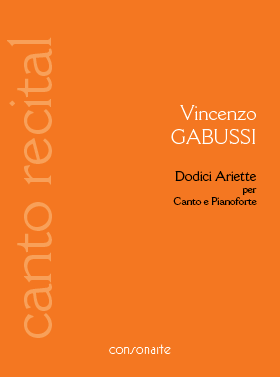Vincenzo Gabussi – Dodici Ariette
Vincenzo Gabussi
Dodici Ariette for Voice and Piano
1826
Critical revision Emilio Sala
Score editing Alessandro Monga
Includes Guarda che bianca luna, the Arietta for a long time attributed to Vincenzo Bellini!
On 3 May 1827, Rossini wrote from Paris to Giuditta Pasta, who was at that time living in the English capital, a letter of introduction of behalf of “this admirable young man whose talent and personality will do credit to you and to all those willing to take an interest in him.” Vincenzo, a native of Bologna, was the younger brother of Giuseppe Gabussi, father of the singer Rita Gabussi and a famous patriot (like Carlo Pepoli, he fled from Bologna after the 1831 uprising). In London, Vincenzo had great success as a singing master and composer of vocal chamber music, so much so that Francesco Regli, in his famous Dizionario biografico (1860), described him as a ‘new Schubert’ […] The Dodici Ariette contributed in no small measure to launching Gabussi at an international level. […] Significant is the presence in the Dodici Ariette of a text such as Guarda che bianca luna (no. 7) by Jacopo Vittorelli, justly described by Carlida Steffan as an obligatory “textual crossroads”, tackled by dozens of composers (it was set to music not only by Giovanni Battista Perucchini but also by, among others, Schubert, Donizetti, and Verdi).
Vincenzo Gabussi
Dodici
Ariette for Voice and Piano
1826
Critical revision Emilio Sala
Score editing Alessandro Monga
- L’estasi amorosa Andante con moto
- La neve Allegretto scherzoso
- La schiavitù d'Amore Andante con moto
- L’inesperienza Allegro grazioso
- La desolazione Andante
- L’incostanza velata Andantino
- La luna Andante con molta grazia
- L’amorosa ingenuità Allegretto, Scherzoso con moto
- Ode sopra Amore Andantino non tanto
- La protesta d'Amore Andante con grazia
- L’invito a Cloe Allegretto sentimentale
- L’estrema preghiera Molto Adagio
- For medium female or male voices.
- Vocal extension: C3 - G4
| Publisher | © 2017 Consonarte |
|---|---|
| Catalogue No. | C705 |
| Format | Paper |
| Language | Italian / English |
| Pages | 96 |
| Dimensions | 310mm x 230mm |
| Score Weight | 370gr |
| ISMN | 979-0-708148-99-9 |
‘Guarda che bianca luna’: Gabussi & Bellini, Homonimy?

When in 1826 Vincenzo Gabussi (1800–1846) published his Dodici Ariette con accompagnamento di pianoforte with Ricordi, he was about to move to London. On 3 May 1827, Rossini wrote from Paris to Giuditta Pasta, who was at that time living in the English capital, a letter of introduction on behalf of “this admirable young man whose talent and personality will do credit to you and to all those willing to take an interest in him. […]
The tradition — not without its mythological dimension — of masters of Italian “bel canto” in London dates back to the great success that Porpora had in this role in the 1730s. A continuous thread may be traced linking a number of his compatriot musicians, in particular his pupil Domenico Corri, who had been in England and in London from the 1780s onwards, which corresponds to what is an ongoing story – that of the fascination (of not only the English) with Italian singing. […]
But predominant among those who especially prepared the ground for Gabussi was the legendary Rossinian singer Manuel García. In The Times of 30 January 1824 we read that García had opened a singing academy in his home (21 Dover Street, Piccadilly), “for the express purpose of giving lessons in the ART of ITALIAN SINGING” (the capitalisation is in the original). It is no coincidence that in the same year he also published his Exercises and Method for Singing. His teaching method was directed at both amateurs and those who intended to pursue a career as a professional singer. […]
Gabussi arrived in the English capital shortly afterwards, as we have seen, in 1827. He immediately became very popular. In Lady Morgan’s Memoirs Gabussi is mentioned more than once. In the entry dated 4 August 1833, Lady Sidney Morgan writes: “Yesterday Bellini and Gabussi came, and sang and played like angels.” Bellini may have sung his “romanzetta” Vaga luna, which was in fact, as indicated on the frontispiece of the Ricordi edition, “composed in London”. Moreover, Bellini and Gabussi belonged to the same generation and Bellinian echoes shine through in some of the latter’s ariette. In arietta No 4 of the Dodici Ariette (entitled L’inesperienza), to which I refer the reader, it is also possible to detect a Gabussian infl uence on Bellini. […]
But as regards interquotation between Gabussi and Bellini, it is impossible not to mention one instance of an ‘unintentional’ type of interquotation, which Anna Bonitatibus (publisher and patron of this invaluable series) recognized at once. One of Gabussi’s Dodici Ariette (No 7, a setting of the famous text Guarda che bianca luna) is identical to that of Bellini’s setting of the very same words. How is that possible? […]
Emilio Sala
Extract from the presentation essay written for Dodici Ariette by Vincenzo Gabussi
1 July 2017 © Consonarte


